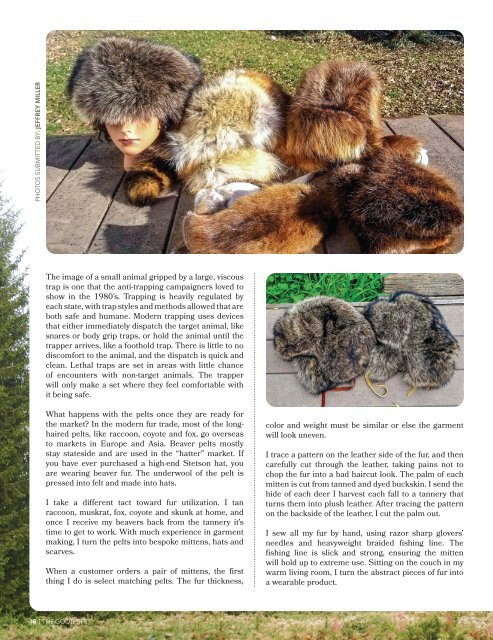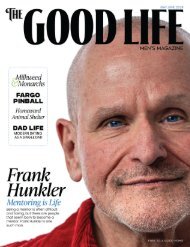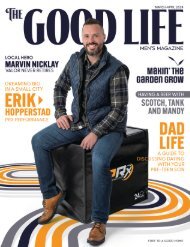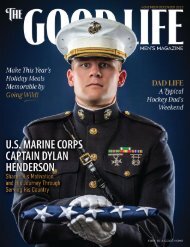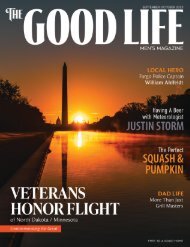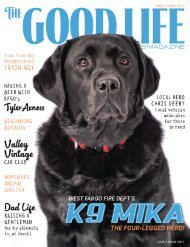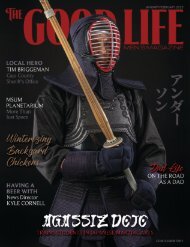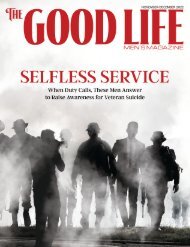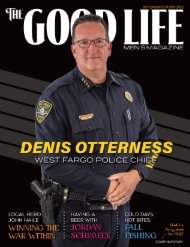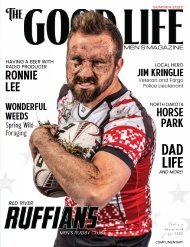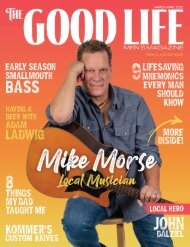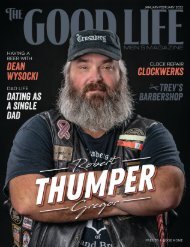The Good Life – January-February 2024
On the cover – Artist and illustrator, Matt Mastrud aka “Punchgut.” Also in this issue – Dad Life with funny and relatable stories showing what it means to be a loving and involved parent. Our Having A Beer with segment: a light-hearted interview giving our readers a glimpse into the lives of well-known men in our community. Also in every issue, a Local Hero showcasing men who are making a positive impact and inspiring others to do good.
On the cover – Artist and illustrator, Matt Mastrud aka “Punchgut.” Also in this issue – Dad Life with funny and relatable stories showing what it means to be a loving and involved parent. Our Having A Beer with segment: a light-hearted interview giving our readers a glimpse into the lives of well-known men in our community. Also in every issue, a Local Hero showcasing men who are making a positive impact and inspiring others to do good.
You also want an ePaper? Increase the reach of your titles
YUMPU automatically turns print PDFs into web optimized ePapers that Google loves.
PHOTOS SUBMITTED BY: JEFFREY MILLER<br />
<strong>The</strong> image of a small animal gripped by a large, viscous<br />
trap is one that the anti-trapping campaigners loved to<br />
show in the 1980’s. Trapping is heavily regulated by<br />
each state, with trap styles and methods allowed that are<br />
both safe and humane. Modern trapping uses devices<br />
that either immediately dispatch the target animal, like<br />
snares or body grip traps, or hold the animal until the<br />
trapper arrives, like a foothold trap. <strong>The</strong>re is little to no<br />
discomfort to the animal, and the dispatch is quick and<br />
clean. Lethal traps are set in areas with little chance<br />
of encounters with non-target animals. <strong>The</strong> trapper<br />
will only make a set where they feel comfortable with<br />
it being safe.<br />
What happens with the pelts once they are ready for<br />
the market? In the modern fur trade, most of the longhaired<br />
pelts, like raccoon, coyote and fox, go overseas<br />
to markets in Europe and Asia. Beaver pelts mostly<br />
stay stateside and are used in the “hatter” market. If<br />
you have ever purchased a high-end Stetson hat, you<br />
are wearing beaver fur. <strong>The</strong> underwool of the pelt is<br />
pressed into felt and made into hats.<br />
I take a different tact toward fur utilization. I tan<br />
raccoon, muskrat, fox, coyote and skunk at home, and<br />
once I receive my beavers back from the tannery it’s<br />
time to get to work. With much experience in garment<br />
making, I turn the pelts into bespoke mittens, hats and<br />
scarves.<br />
When a customer orders a pair of mittens, the first<br />
thing I do is select matching pelts. <strong>The</strong> fur thickness,<br />
color and weight must be similar or else the garment<br />
will look uneven.<br />
I trace a pattern on the leather side of the fur, and then<br />
carefully cut through the leather, taking pains not to<br />
chop the fur into a bad haircut look. <strong>The</strong> palm of each<br />
mitten is cut from tanned and dyed buckskin. I send the<br />
hide of each deer I harvest each fall to a tannery that<br />
turns them into plush leather. After tracing the pattern<br />
on the backside of the leather, I cut the palm out.<br />
I sew all my fur by hand, using razor sharp glovers’<br />
needles and heavyweight braided fishing line. <strong>The</strong><br />
fishing line is slick and strong, ensuring the mitten<br />
will hold up to extreme use. Sitting on the couch in my<br />
warm living room, I turn the abstract pieces of fur into<br />
a wearable product.<br />
16 | THE GOOD LIFE


